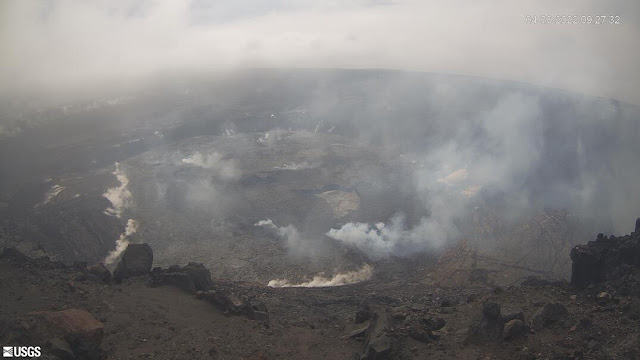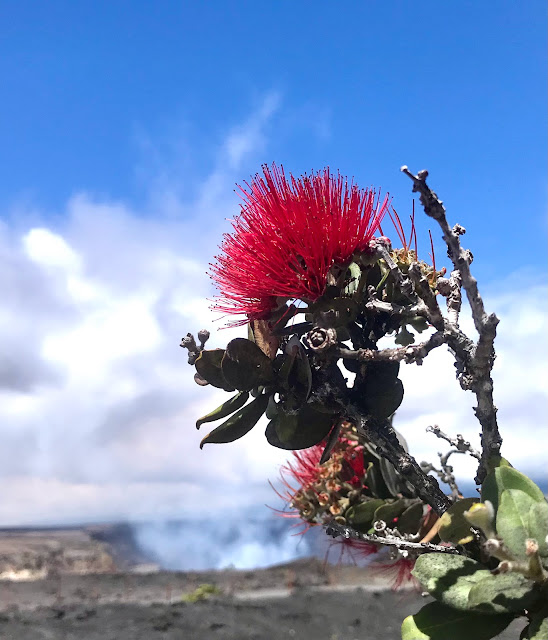Today marks four years since the trigger was released at 2pm April 30, 2018, that began the Hulihia of 2018. The Three Months (May-July) that followed are, for some of us, indelibly etched in our being. That day was rainy, just as it is today. Mistyfoggy so that the remote cameras out at Puʻuʻōʻō couldnʻt show us what was happening. So we waited to see what was unveiled. And what was revealed through the fog and steam was an empty pit. After thirty-five years, emptiness. After months and weeks of increasing magma supply feeding the plumbing system, and the little lava lake on the floor of Halemaʻumaʻu, active for 10 years, overflowing, and the floor of Puʻuʻōʻō rising, the rift zone ruptured. Just like that.
The rupture began an unstoppable process. Magma traveled downrift toward Kumukahi, the heralded eastern tip of the Island of Hawaiʻi where the sun, each morning, greets our pae ʻāina, our archipelago. Pelehonuamea, that awe-full force of volcanism, the creator of our land appeared, again, in Keahialaka. As fissures opened and fountains of lava played, pipelines were open and draining. Lava disappeared from sight in Halemaʻumaʻu, the traditional home of Pele, and the ground began to tremble.
And today we remember, though for some of us, memories of those Three Months are always lurking. Pua Johnson and I talked soon after the Hulihia began, and she reminded me of the word:
PU-I-WA
... a stupefaction on account of wonder;
Found in the 1865 "A Dictionary of the Hawaiian Language" by Lorrin Andrews, "pūʻiwa" completely, totally, and absolutely captures, portrays, and summarizes Those Three Months.
And I wonder, too, at this:
 |
Ka wai mūkīkī
ʻapapane sip
glistening nectared cuplets
trembling in breezes |
Remember when had to buy film, and no could take too many pictures because had to develop and was expensive? Well. Now weʻre surrounded with tens of thousands of images. Take as many as you want, and share away. Couple weeks ago at Keanakākoʻi, with my iPhone 7Plus (mahalo, jp), I got lucky. It was blustery and overcast. Many of you know that Iʻm fairly obsessed with ʻōhiʻa lehua. I must have hundreds of pictures of lehua: tight tight white buds, reddened buds, and all stages of unfurling lihilihi (collectively, stamens and pistil, a poetic reference to eyelashes), the fattening of seed pods, and the eventual release of tiny propagules to the winds. But the photo above dazzles.
A single pua lehua, ringed with red, white-fringed petals, the sturdy central kukuna (female pistil), surrounded by pollen-tipped male pōuleule (stamens), all reflected in a sea of wai pua (nectar). I remain dazzled.
And we are dazzled too by the sea of pele in Halemaʻumaʻu. We remain grateful for the dedicated and diligent staff of the Hawaiian Volcano Observatory for allowing all access to webcam images, photos, video, maps, etc etc etc.
This rainy morning, bluish fume is tradewind blown and The Pit is encircled by white steams.
Recently weʻve watched as a little loko ʻahi, a new version of the lava lake has evolved. Itʻs the same one thatʻs been active for months, but pele now seems a constant presence. Cooled crustal plates are rafted about by unseen currents, silvery textures always refreshed.
Two days ago:
The two images above are from the "V1" camera. HVO staff move the camera as needed so views of Her work are captured as She travels there and here.
Many visitors say: "I was here ____ ago. Is it still...??" And of course the answer is no. While an eruption may be long-lived, the particulars of style, of where, how intense (or not), are always always changing. What you see is what you get, and itʻs all worthwhile.
To re-emphasize the ephemeral nature of the works of Pele, her whim, and our reactions and perhaps expectations... We must never expect anything to last.
The three images below were all taken from more-or-less the same aerial vantage point, all from HVO.
 |
| April 13, 2018 |
 |
| July 28, 2018 |
 |
| March 2, 2022 |
Views toward Maunaloa. That patch of greenish is pasture of Kapāpala Ranch, the right-hand side is named ʻŌhaikea, site of a large battle, late 1700ʻs.
After the 62 lūʻōniu (collapse events) during The Three Months, Halemaʻumaʻu was an inverted cone. The current loko ʻahi (lava lake) is just over a thousand feet deep. Two maps below for you to peruse and practice math.
Our ao māhu, that cloud of steams and gases that, depending on weather, hovers over Kaluapele, is the little puff at left, just above the highway. Still beckoning.
This season of animation means that everybody seems intent on putting on a show. Red liko ʻōhelo (below) blaze, and everyone else is shooting, flushing, unfurling... allowing us to enjoy the scene. Pele favors ʻōhelo, as do nēnē.
And we are entering, at least up here, peak lehua bloom. Endlessly fascinating are the flowers. Each ʻōhiʻa is different, with subtle variations of all its parts: stature, leaves, liko (leaf shoots), pua (flowers). The diversity, if one is Outside and is Paying Attention, is absolutely impressive.
Battered by rain yesterday, some describe ka ua kani lehua:
Then a random assortment of colors, and shapes, and stages, and...
 |
| Fuzzy grey sepals, maroon petals. |
 |
| Green sepals rather than grey, with pink petals. Photo by mjo |
A few days ago at Keanakākoʻi, fume rises from Halemaʻumaʻu as lehua bloom.
In another era, fume rises from Halemaʻumau, as lehua bloom next to the September 1982 flow
on April 27, 2018.
And just because, a rain-dropped nēnē feather caught in a pavement crack day before yesterday.
And here we remain, grateful for the rains, the sun, our health, and most of all for the support and encouragements of loved ones. We send heartfelt prayers to those besieged and dying in Ukraine.
 |
| amazon.com |
Be well.
Aloha, always aloha,
BobbyC
























No comments:
Post a Comment